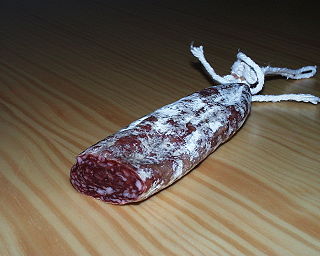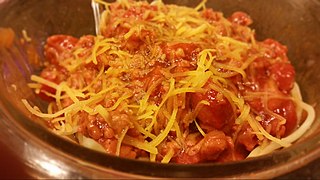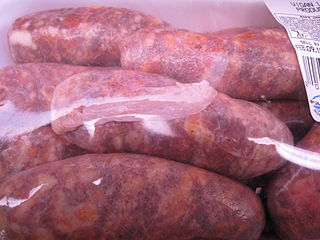
Fried rice is a dish of cooked rice that has been stir-fried in a wok or a frying pan and is usually mixed with other ingredients such as eggs, vegetables, seafood, or meat. It is often eaten by itself or as an accompaniment to another dish. Fried rice is a popular component of East Asian, Southeast Asian and certain South Asian cuisines, as well as a staple national dish of Indonesia. As a homemade dish, fried rice is typically made with ingredients left over from other dishes, leading to countless variations. Fried rice first developed during the Sui Dynasty in China.

Longaniza is a Spanish sausage (embutido) similar to a chorizo and also closely associated with the Portuguese linguiça. Its defining characteristics are interpreted differently from region to region. It is popular in the cuisines of several regions of Spain, Argentina, Uruguay, Puerto Rico, Dominican Republic, El Salvador, Guatemala, Mexico and Chile. In the Philippines, it is called longganisa and has hundreds of variants with different vernacular tastes and forms due to the 144 ethno-linguistic groups of the archipelago.

Hamonado, or hamonada, is a Filipino dish consisting of meat marinated and cooked in a sweet pineapple sauce. It is a popular dish during Christmas in Philippine regions where pineapples are commonly grown. Hamonado is also a general term for savory dishes marinated or cooked with pineapple in the Philippines.

Embutido, or embotido, is a Philippine meatloaf made with ground pork and stuffed with hard-boiled eggs and sliced ham or various sausages. It is traditionally wrapped in aluminum foil and steamed, though it can also be baked.

Morcón or morconito, is a Philippine braised beef roulade made with beef flank steak stuffed with hard-boiled eggs, carrots, pickled cucumber, cheese, and various sausages. It is commonly served during Christmas and other festive occasions.

Paelya or paella (Spanish), is a Philippine rice dish adapted from the Valencian paella. However, it differs significantly in its use of native glutinous rice (malagkít), giving it a soft and sticky texture, unlike the al dente texture favoured in Spanish paella. It is also characteristically topped with sliced eggs. Filipino paelya does not use saffron, but is instead coloured with atsuete (anatto), luyang diláw (turmeric), or kasubhâ (safflower).

Filipino spaghetti is a Filipino adaptation of Italian spaghetti with Bolognese sauce. It has a distinctively sweet sauce, usually made from tomato sauce sweetened with brown sugar and banana ketchup. It is typically topped with sliced hot dogs or smoked longganisa sausages, giniling, and grated cheese. It is regarded as a comfort food in Philippine cuisine. It is typically served on almost any special occasion, especially on children's birthdays.
Alaminos longganisa, also known as longganisa Pangasian, is a Filipino pork sausage originating from Alaminos, Pangasinan. It is a type of de recadolongganisa. It is made with ground lean pork, ground pork fat, brown sugar, coarse salt, saltpeter, black pepper, vinegar, and garlic in hog casings. It is typically bright yellow or orange due to the use of achuete seeds.

Vigan longganisa, also known as the Ilocano longganisa, is a Filipino pork sausage originating from Vigan City, Ilocos Sur. It is a type of de recadolongganisa. It is made with ground lean pork, ground pork fat, brown sugar, garlic, onions, bay leaves, soy sauce, vinegar, black pepper, and salt to taste in hog casings. Chili flakes may also be added. The sausages are celebrated in an annual "Longganisa Festival" in Vigan City.

Chorizo de Macao, sometimes called Chinese Chorizo or Longaniza Macau, is a Filipino dry pork sausage. The ingredients of Chorizo de Macao is identical to other Filipino sweet longganisas, except for its dry texture and its use of star anise, aniseed, or anise liqueur (anisado), which gives it its distinctive aroma and its name. It is commonly used in Chinese Filipino dishes like pancit Canton and siopao. It is sometimes confused with and used in place of Chinese sausage.

Chorizo de Cebu, also known as longganisa de Cebu, is a Filipino pork sausage originating from Cebu. It is a type of hamonada (sweet) longganisa. They are distinctively red in color due to the use of achuete seeds. Each link is also usually spherical in shape. It is made from ground lean pork, ground pork fat, salt, saltpeter, sugar, anise liqueur (anisado), paprika, black pepper, garlic, and chilis to taste in a hog casing. It can also be made without the casing. They are usually fried or grilled and eaten with white rice, puso, or garlic rice for breakfast.
Chorizo negrense, also known as chorizo de Bacólod, is a Filipino smoked pork sausage originating from Bacolod, Negros. It comes in two flavors: hamonado (sweet) and recado (garlicky). It can be prepared smoked in a casing, or prepared fresh without the casing. It is made with ground pork, vinegar, garlic, calamansi, soy sauce, black pepper, and coarse salt. Sugar is added to the hamonado version.
Cabanatuan longganisa, also known as batutay, bototay, or batotay, depending on the municipality, is a Filipino beef sausage originating from Cabanatuan in the province of Nueva Ecija. It can be served sweet (hamonado), garlicky, or "skinless". It is celebrated in the annual "Longganisa Festival" of Cabanatuan.

Calumpit longganisa, also known as longganisang bawang, is a Filipino pork sausage originating from Calumpit, Bulacan, Philippines. It is a type of de recadolongganisa. It is made with lean pork, pork fat, garlic, bay leaves, brown sugar, soy sauce, vinegar, salt, black pepper, paprika, and optionally, chili.

Pampanga longganisa is a Filipino pork sausage originating from the province of Pampanga. It is a type of hamonado (sweet) longganisa. It is typically longer and thinner than other Philippine sausages. It is made with pork, garlic, brown sugar, black pepper, coarse salt, and vinegar. It can be prepared with or without the casing. It is typically dyed orange or red with achuete seeds. It is the most common sweet-type longganisa eaten throughout the Philippines, since it is commercially mass-produced.

Lucban longganisa is a Filipino pork sausage originating from Lucban, Quezon. It is a type of de recadolongganisa. It is characterized by its use of oregano and its garlicky and sour taste. It is made with lean pork, pork fat, coarse salt, garlic, oregano, paprika, sugar, and vinegar. It can be prepared with or without the casing.
Tuguegarao longganisa, also known as the Ybanag longganisa, is a Filipino pork sausage originating from the Ybanag people of Tuguegarao City, Cagayan. It is a type of de recadolongganisa. It is made with coarsely ground pork, black pepper, garlic, coarse salt, and cane vinegar in hog casings. It is typically dyed orange with achuete oil.

A chori burger, also known as a chorizo burger, is a Filipino hamburger characteristically made with chorizo (longganisa) patties, banana ketchup, mayonnaise, and atchara, in addition to tomatoes and lettuce. It was first popularized by Merly's BBQ, a street food stall in the island of Boracay in the Philippines. A version of the burger with a half-longganisa and half-beef patty from Jeepney Restaurant was declared the best burger in New York City in Time Out's 2014 "Battle of the Burgers" competition.
Fish longganisa, or fish chorizo, is a Filipino sausage made with fish instead of pork or beef. It is typically made from tuna, tilapia, or milkfish. It is prepared identically to other Filipino longganisa and is marketed as a healthier alternative. It may use regular pork casings, vegetable-based casings, or be prepared "skinless".
Baguio longganisa is a Filipino pork sausage originating from the city of Baguio. It is a type of hamonado (sweet) longganisa.















